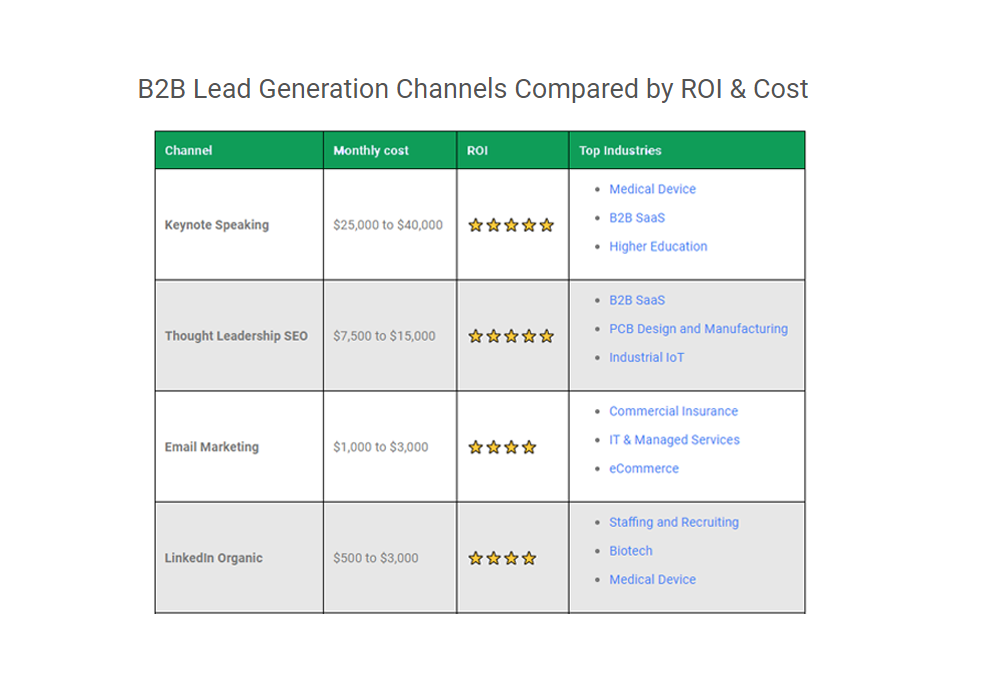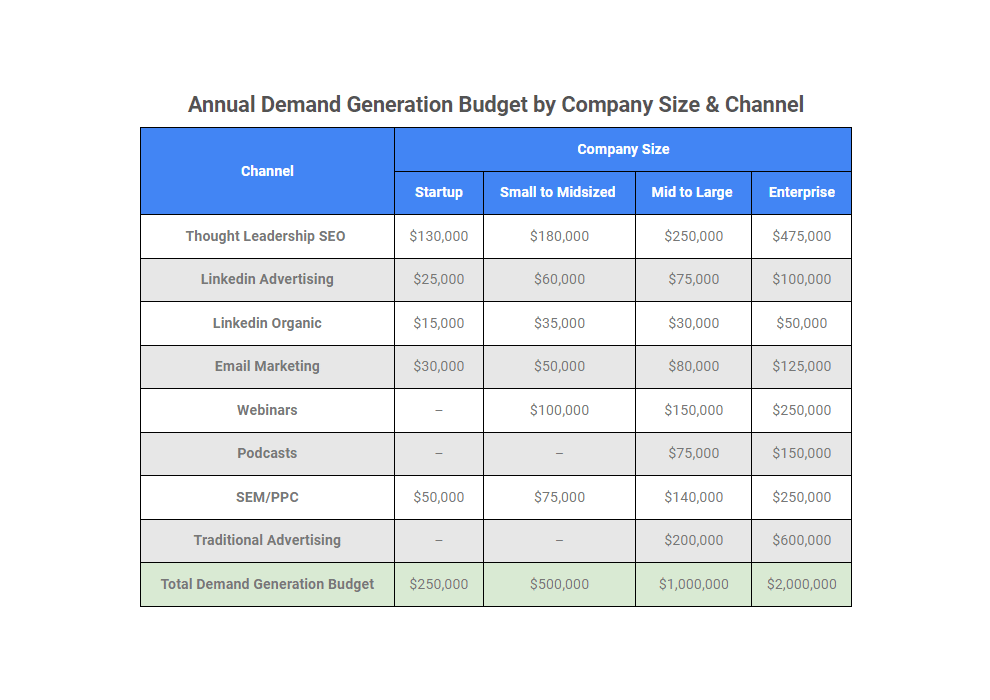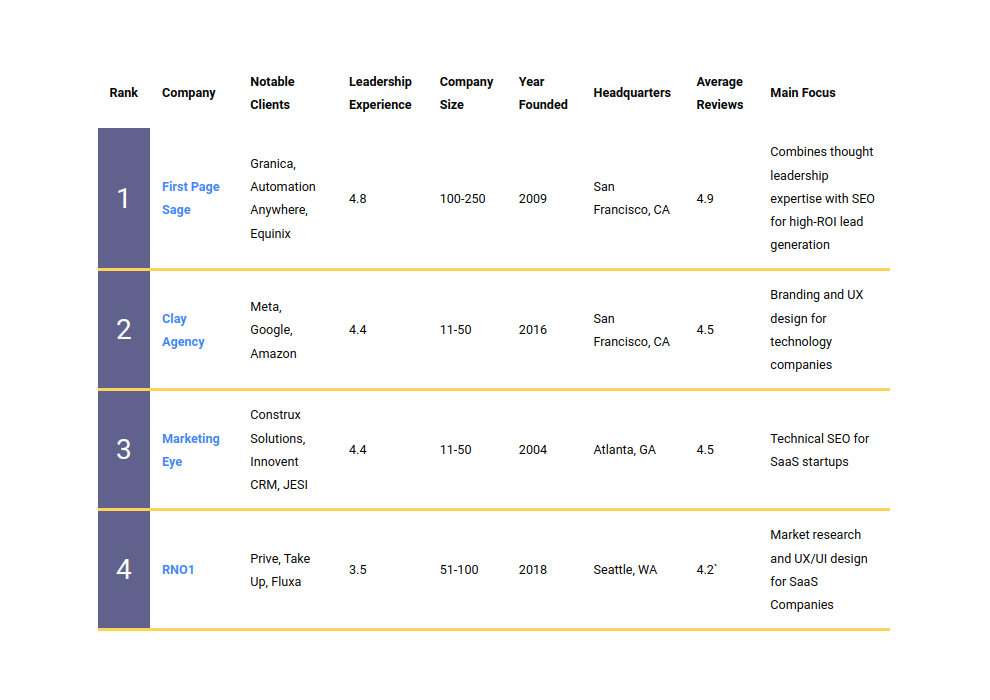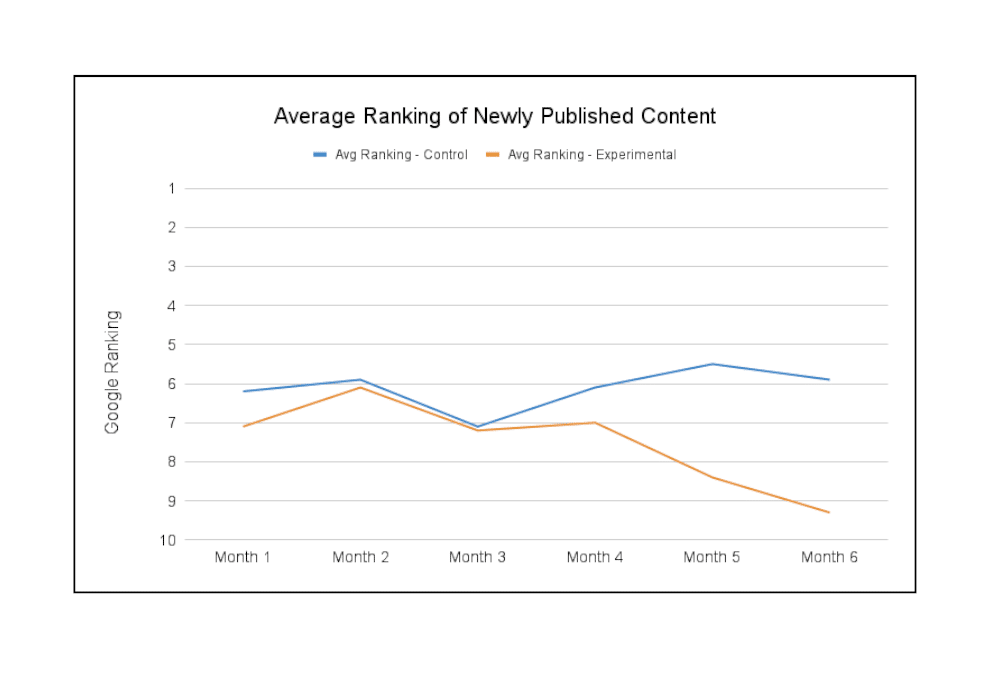Choosing the right B2B lead generation channels from the wide variety available is essential to business growth. Our team compiled data from marketing campaigns with 150+ B2B companies to create this guide. Our data set comes from a spectrum of industries, heaviest in tech, finance, real estate, and industrial.
Below, we compare the cost and ROI of 11 lead generation channels, highlighting the industries that perform best in that channel. We then discuss the pros and cons of each channel in greater detail.
B2B Lead Generation Channels Compared by ROI & Cost
| Channel | Monthly cost | ROI | Top Industries |
| Keynote Speaking | $25,000 to $40,000 | ⭐⭐⭐⭐⭐ | |
| Thought Leadership SEO | $7,500 to $15,000 | ⭐⭐⭐⭐⭐ | |
| Email Marketing | $1,000 to $3,000 | ⭐⭐⭐⭐ | |
| LinkedIn Organic | $500 to $3,000 | ⭐⭐⭐⭐ | |
| PPC / SEM | $3,000 to $30,000 | ⭐⭐⭐ | |
| LinkedIn Advertising | $5,000 to $20,000 | ⭐⭐⭐ | |
| Trade Shows | $10,000 to $20,000 | ⭐⭐⭐ | |
| Podcasts | $5,000 to $9,500 | ⭐⭐⭐ | |
| Public Relations | $10,000 to $50,000 | ⭐⭐ | |
| Video | $15,000 to $35,000 | ⭐⭐ | |
| Direct Mail | $1,500 to $10,000 | ⭐ |
The Pros and Cons of Each Lead Generation Channel
We now elaborate on the strategic considerations of each channel.
Keynote Speaking
The single highest-ROI lead generation channel is presenting a keynote speech at an in-person industry conference.
Pros:
Having the stage confers an authority that no other channel can replicate. You’ll also have your audience’s undivided attention, giving you the best chance to make a strong impression. The in-person event also allows you many opportunities to make connections afterward, and giving a great speech ensures that your audience will have a reason to want to talk to you in the first place. When you become a regular speaker at events, it also affords you credibility in your other channels.
Cons:
The downside to keynote speaking at premium conferences is that it is nearly impossible to earn, and extremely expensive to buy. Conferences are events, and their organizers are trying to create the best experience for attendees – that often means booking well-known experts or celebrities for the keynotes. While you can earn your way into one of those slots, the combination of natural talent and years of reputation-building required make the number of people capable of earning a top keynote speaking slot vanishingly small.
As for buying a keynote opportunity, the healthcare conferences with the highest-level attendees now charge upwards of $200,000 for a sponsorship that includes a speaking slot.
Thought Leadership SEO
The next best thing to keynote speaking—essentially the written form of it—is thought leadership-centered SEO.
Pros:
Done properly, this lead generation channel has both high ROI and long term sustainability. A single excellent article that achieves a high Google ranking can generate qualified leads for years without further investment. As an organic channel, it also results in higher visitor trust, and therefore, higher conversion rates. Finally, the content you create can also be repurposed for other organic channels, such as LinkedIn and email marketing.
Cons:
The downside to SEO is its difficulty and lead time. It requires expertise not only in your industry, but also in creating high-quality thought leadership content. This content must consistently target the right keywords, satisfy search intent, and bring your visitors through the B2B marketing funnel. In addition, it will take 4–6 months from the beginning of a campaign to begin seeing results—longer if you publish less than twice a week. When executed skillfully, however, thought leadership marketing has well below average Customer Acquisition Costs.
Email Marketing
Email marketing is an extremely effective lead generation channel due to its low cost and utility in nurturing leads.
Pros:
All that is required is a list of contacts and content to send to them. Of particular note is that when a company already has a thought leadership campaign, that content has already been created.
Cons:
This channel is most effective when your lists have been organically built over time and segmented based on industry, customer type, and any other relevant category. Infrequent emails serve as reminders or updates about your business to existing customers and potential clients, and can revive a cold lead. Over-sending emails, however, will lead to unsubscribe requests and can harm your relationships with prospects, which is why we recommend sending emails once a month at most.
LinkedIn Organic
Posting on LinkedIn is high-ROI when executed over a long-term period, largely because it’s an organic channel, and the only your entire B2B audience likely uses.
Pros:
When you post on LinkedIn, you can be assured that your readers are already in a business mindset and will be receptive to posts. In addition, you can use existing content, reformatted, to build your LinkedIn content library.
Cons:
This is also a channel that benefits heavily from a preexisting thought leadership campaign. Your blog posts and white papers can be distilled for LinkedIn articles, reducing the cost significantly.
PPC / SEM
PPC is a tried and true paid channel that ranges in expense and can yield decent results.
Pros:
Search ads, particularly through Google Adwords, are a go-to for B2B online marketers precisely because they’re so measurable. PPC is best used for short-term, specific goals. Paid search campaigns can generate leads immediately if managed correctly, with a careful eye on performance and spend.
Cons:
Successful PPC campaigns can be difficult to execute because they require regular keyword research, testing, and refinement, as well as a clearly defined scope. They’re most effective when used in combination with an organic SEO campaign, in two use cases. The first is to bridge the gap between the start of the SEO campaign and when that SEO campaign begins to generate leads. The second is to test out a new market or to target a secondary audience without the commitment inherent to SEO.
LinkedIn Advertising
Advertising on LinkedIn is more effective than many people realize, and while it’s not as high-ROI as the organic channels listed above, it’s a good performer on the paid side.
Pros:
LinkedIn Advertising offers the benefit of being able to target your ads to specific job titles, locations, industries, and even companies, allowing you to craft the perfect pitch for each audience you target. Conversion rates on LinkedIn ads are also pretty good for a paid channel.
Cons:
LinkedIn users will not attribute the same degree of trust to an ad that they will to a well crafted article. One thing to keep in mind about LinkedIn Advertising is that—as with most paid channels—it is expensive compared to its organic counterpart. Much like PPC, you will only generate leads so long as you continue your ad spend, and LinkedIn raises its ad prices every year.
Trade Shows
Particularly in the post-COVID world, face-to-face opportunities can bring in warm leads; however, conferences vary widely in quality and the level of trust attendees have for vendors.
Pros:
In-person trade shows offer a quick, tangible way to do market research and get exposure to your target audience. In-person contacts also tend to be deeper than those made online, and if you’re in an industry that isn’t geographically dependent like B2B SaaS, trade shows are one of the only ways of creating face to face connections with distant customers. The event can also be dual purpose, serving as an opportunity for your team to learn about new developments in your industry.
Cons:
Trade shows, though, are another expensive channel. Even when the cost of the exhibition space or conference itself is relatively low, the physical marketing materials, travel, and lodging add up quickly. You’ll also be competing directly with other exhibitors for attention—even with other companies that aren’t within your niche.
Podcasts
If people can find your show in the inundated world of podcasts in 2023, your reward is a highly engaged audience.
Pros:
A podcast, when targeted properly, can be one of the most engaging B2B lead generation channels. You have a captive audience of potential customers on their commute, doing exercise, or generally in state when they’re open to being influenced.
Cons:
Podcasts require you to have the audio production experience to create a high quality experience for your listeners. You will also need experts on staff who are charismatic and able to devote the time necessary to recording the podcasts themselves.
Public Relations (PR)
Costly and complicated, public relations delivers results on the lower end of the spectrum; however, the right press hit can be extremely valuable.
Pros:
Traditional PR, focused on news channels, blogs, TV, and radio, takes a lot of manpower, resulting in an expensive lead generation channel that has the potential to make a huge impact. The trust and goodwill that can come from a trusted media outlet running a positive story on your business is impossible to replicate.
Cons:
Generally, the cost-benefit equation makes it so only the best-funded companies have the resources to hire talented PR staff or agencies. The process of PR is also so hit-and-miss that it wouldn’t be unusual to be down a few hundred thousand dollars and see no meaningful results.
Video
The magic of video is the blending of words, music and images to tell stories in an easy-to-understand way. However, while very useful for conversion, video is not a top-of-funnel lead generation channel.
Pros:
Video is an efficient way to illustrate difficult concepts, and can also provide a one-way social connection that builds trust with your viewers. It provides a way for your customers to associate a face with your products and services, without needing to meet in person.
Cons:
Like podcasts, video can quickly turn very expensive. Professional-grade video production easily tops six figures, and lower quality video can sometimes do more harm than good. Unlike with podcasts, videos also demand undivided attention so busy decision makers often won’t find the time to watch a lengthy video.
Direct Mail
Direct mail is expensive and ROI is minimal, making it an ineffective lead generation channel.
Pros:
Direct mail—classic paper-in-envelopes or postcards—has a retro feel to it these days and can work for more old-fashioned industries. Sometimes, a physical reminder can help someone remember your company’s information if they intend to reach out later.
Cons:
Combining all the downsides of paid channels and physical media, direct mail is expensive. Even if you do reach a decision maker that doesn’t have their “snail mail” screened, you need to capture their attention in the 5 seconds it takes them to walk from their mailbox to their trash bin.
Getting Help with B2B Lead Generation
The highest-ROI lead-generation strategies require creative, industrious marketing teams to execute—either in-house or external. Particularly if you haven’t run a highly successful lead generation program through a particular channel, it can make sense to work with a talented vendor before taking the program in house.
Our marketing agency has been providing B2B lead generation services for more than 12 years. If you’re interested in discussing a campaign, let’s connect.



